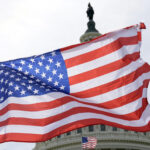

An alarming occurrence of violent crime could be seen throughout Washington, D.C., in 2023, as other big cities saw rates of crime plummet.
End-of-the-year crime data released by the Metropolitan Police Department doesn’t dive into the root causes of what has driven or exacerbated D.C.’s issues in recent years. D.C. officials, members of Congress, and community advocates all have proposed reasons behind the city’s high crime rate. Some have connected the gentrification of once majority black neighborhoods to an unrest, leading to more crime, while others blame local Democratic policies for being “soft-on-crime” amid a shrinking police force.
A look into the numbers
The District ended 2023 with a 26% increase in overall crime compared to last year, according to data published by the MPD. That included a 39% increase in violent crime and a 24% increase in property crime, bringing the total instances to 34,414.
The nation’s capital recorded the highest murder rate since 1997, with 274 killings in 2023, an increase of 35% over the prior year and positioning D.C. as the fifth-highest murder rate out of the nation’s big cities.
Gentrification and displacement
Some studies point to gentrification as a factor in a rise in crime, especially during the early stages of redevelopment.
Tanya Golash-Boza is the executive director of the University of California Washington Program (UCDC) and author of Before Gentrification: The Creation of DC’s Racial Wealth Gap.
Golash-Boza studied low-income neighborhoods with concentrated poverty, where high crime rates are a common theme. But Golash-Boza pointed out there is another set of neighborhoods with high rates of homicide, like ones seen in D.C., that have undergone gentrification and have high levels of inequality
“A neighborhood that’s poor and disinvested, and in D.C. that’s almost always gonna be a majority black neighborhood, that experiences an influx of high-income people, that creates this kind of inequality at the micro level,” Golash-Boza told the Washington Examiner. “And that itself leads to frustration. And what we’re seeing in D.C., that also leads to increases in the homicide rate.”
Inside the neighborhoods
Navy Yard has been described as the most gentrified neighborhood in the city. Once known as a historic Naval shipbuilding and shipfitting facility, the neighborhood that sits on the Anacostia River in the southeast has transformed rapidly and is now home to dozens of high-rise apartments, luxury restaurants, bars, and shops.
“Navy Yard is a very high-income neighborhood, so you would not expect it to have high rates of homicide,” Golash-Boza said, emphasizing “homicide tends to be concentrated in poor” areas.
“But Navy Yard is adjacent to a very high poverty neighborhood — the neighborhood right next to it is predominated by public housing,” Golash-Boza said. “It’s right across the river from Anacostia.”
Year after year, crime rates in Anacostia, a historic neighborhood in southeastern D.C., exceed the rest of the city.
While “empty lots and dilapidated buildings” are spread across areas of southwest and along the east river, residents in those poorer areas are aware of the “bright and shiny” buildings across the way in Navy Yard.
“Not only are you poor, but also you’re just very aware that you’re getting the short end of the stick because it’s very clear that somebody is putting a lot of money into Navy Yard,” Golash-Boza said.
Millions have been invested into modernizing historic spaces in Navy Yard.
In 2001, the District of Columbia Housing Authority received a $34.9 million HOPE VI grant from the Department of Housing and Urban Development to redevelop the Arthur Capper/Carrollsburg Dwellings public housing community into a mixed-income space.
Initially promising more than 700 public housing units throughout Capitol Riverfront and Navy Yard neighborhoods, its master plan website states the development is approximately 70% built out as of 2020. The project received criticism for its slow progression and displacing public housing residents.
“I think that seeing that inequality right in front of you exacerbates the violent crime rate because it makes people frustrated,” Golash-Boza said, adding, “people feel like they’re being abandoned by the public and private sectors.”
MPD data shows violent crime in Navy Yard has skyrocketed in recent years, increasing by over 200% from 2020 to 2023 — with a total of 89 incidents last year.
Community efforts
Just across neighboring state lines, Baltimore’s homicide numbers fell by nearly 21% compared to last year, the largest year-over-year drop since about five decades ago.
Marcus Ellis, Peace for DC’s executive director, attributes the drop-off in crime partially to Baltimore’s strong community violence intervention programs, and efforts focusing on the root causes of criminal activity.
“We saw the national numbers come out, and there are spaces and places within the United States that are heavily funded and committed to violence prevention and intervention,” Ellis said. Baltimore, Atlanta, Miami, and New Orleans all saw drops in homicides and violent crime in 2023.
“I would go right up the streets of Baltimore where they have a strong community violence intervention program, a strong strategic plan that they’re implementing that we don’t yet have in the District of Columbia,” Ellis said. “This is gonna be about our city adopting, implementing a true strategic plan that allows everyone to be involved.”.
Washington, D.C., Mayor Muriel Bowser was criticized for her approach to addressing the district’s crime problem in 2023. She opposed the council’s attempts to reduce sentences for a range of violent crimes, instead arguing her city needed to get tougher on offenders.
Ellis disagrees with Bowser’s approach, saying arresting more people to solve the problem of crime is akin to “putting a bandaid on something.”
Ellis was previously the mayor’s chief of staff at the Office of Neighborhood Safety and Engagement, serving over two decades as a government worker.
On the other side: Soft-on-crime and a declining law enforcement
Republicans say the problem with crime in D.C. and other big cities is Democrats’ “soft-on-crime” approach.
House Republicans checked the power of the D.C. city council in an Oversight and Accountability Committee hearing in March, questioning what local policies are doing to decrease violent and property crime. House GOP lawmakers introduced a resolution to overturn a controversial police reform bill made permanent in December 2022, which was widely opposed by the D.C. Police Union. The bill, supported by chairman Phil Mendelson, bans the use of chokeholds by police officers and included improvements in access to police records.
“Our nation’s capital has deteriorated and declined. Crime has risen dramatically, education levels have plummeted, and the city’s finances are in disarray. D.C. officials have not carried out their responsibility to serve their citizens,” said Rep. James Comer (R-KY). “Therefore, our committee must fulfill its responsibility to conduct oversight of the District of Columbia.”
Disputes between Congress, city council, and the mayor’s office
Last year, the D.C. criminal code was nearly overhauled. The Revised Criminal Code Act was the result of more than a decade of studies and suggestions from the D.C. Criminal Code Reform Commission, a nonpartisan agency, before it landed on the city council’s desk. Revisions to the D.C. criminal code were approved by the city council in November 2022 — proposing changes like reducing maximum penalties for certain offenses and letting people charged in misdemeanor cases, who are facing less than six months behind bars, to request a jury trial instead of a bench trial.
Bowser supported a majority of the proposed revisions, but feared some provisions would fail to make D.C. safer and vetoed the code in January 2023. However, the D.C. Council voted 12-1 to overrule the mayor’s veto, prompting Congress to take an interest.
While Bowser vetoed the bill, she opposed congressional intervention in local crime law.
In March, a Republican-led resolution to block D.C. ‘s revised criminal code passed the Senate in an 81-14 vote. For the first time in more than three decades, Congress overturned local D.C. legislation. President Joe Biden signed the resolution into law on March 20.
In a statement to the Washington Examiner, Lindsey Appiah, deputy mayor for Public Safety and Justice said “increasing public safety and reducing crime” is Bowser’s top priority.
“We have far too many people carrying and using illegal guns in our community, and too many people are acting without accountability for the terror they’re inflicting,” Appiah said.
CLICK HERE TO READ MORE FROM THE WASHINGTON EXAMINER
“Whether it’s from school safety leaders, Advisory Neighborhood Commissioners, or in conversations with residents across the city, they have expressed loud and clear they are looking for solutions to fill the gaps in our public safety and justice ecosystem,” Appiah added.
Going into 2024, Appiah said the mayor’s office is “focused on additional policies, policing strategies, and strategic partnerships needed to reduce crime and increase safety in all eight Wards.”







